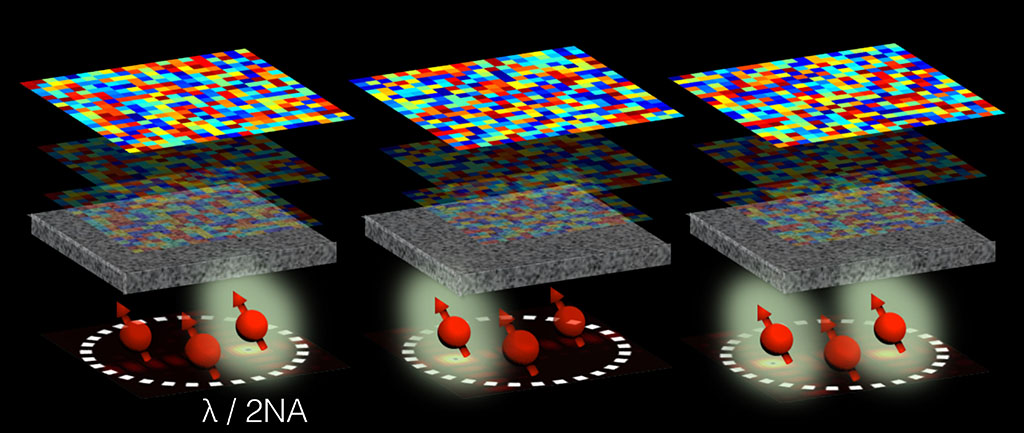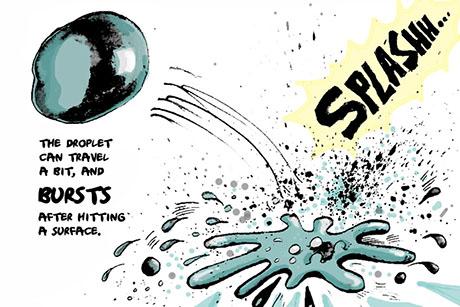Technique could boost resolution of tissue imaging as much as tenfold
Imaging deep inside biological tissue has long been a significant challenge. That is because light tends to be scattered by complex media such as biological tissue, bouncing around inside until it comes out again at a variety of different angles. This distorts the focus of optical microscopes, reducing both their resolution and imaging depth. Using light of a longer wavelength can help to avoid this scattering, but it also reduces imaging resolution.
Now, instead of attempting to avoid scattering, researchers at MIT have developed a technique to use the effect to their advantage. The new technique, which they describe in a paper published in the journal Science, allows them to use light scattering to improve imaging resolution by up to 10 times that of existing systems.
Indeed, while conventional microscopes are limited by what is known as the diffraction barrier, which prevents them focusing beyond a given resolution, the new technique allows imaging at “optical super-resolution,” or beyond this diffraction limit.
The technique could be used to improve biomedical imaging, for example, by allowing more precise targeting of cancer cells within tissue. It could also be combined with optogenetic techniques, to excite particular brain cells. It could even be used in quantum computing, according to Donggyu Kim, a graduate student in mechanical engineering at MIT and first author of the paper.
In 2007, researchers first proposed that by shaping a wave of light before sending it into the tissue, it is possible to reverse the scattering process, focusing the light at a single point. However, taking advantage of this effect has long been hampered by the difficulty of gaining sufficient information about how light is scattered within complex media such as biological tissue.
To obtain this information, researchers have developed numerous techniques for creating “guide stars,” or feedback signals from points within the tissue that allow the light to be focused correctly. But these approaches have so far resulted in imaging resolution well above the diffraction limit, Kim says.
In order to improve the resolution, Kim and co-author Dirk Englund, an associate professor in MIT’s Department of Electrical Engineering and Computer Science and the Research Laboratory of Electronics, developed something they call quantum reference beacons (QRBs).
These QRBs are made using nitrogen-vacancy (N-V) centers within diamonds. These tiny molecular defects within the crystal lattice of diamonds are naturally fluorescent, meaning they will emit light when excited by a laser beam.
What’s more, when a magnetic field is applied to the QRBs, they each resonate at their own specific frequency. By targeting the tissue sample with a microwave signal of the same resonant frequency as a particular QRB, the researchers can selectively alter its fluorescence.
“Imagine a navigator trying to get their vessel to its destination at night,” Kim says. “If they see three beacons, all of which are emitting light, they will be confused. But, if one of the beacons deliberately twinkles to generate a signal, they will know where their destination is,” he says.
In this way the N-V centers act as beacons, each emitting fluorescent light. By modulating a particular beacon’s fluorescence to create an on/off signal, the researchers can determine the beacon’s location within the tissue.
“We can read out where this light is coming from, and from that we can also understand how the light scatters inside the complex media,” Kim says.
The researchers then combine this information from each of the QRBs to create a precise profile of the scattering pattern within the tissue.
By displaying this pattern with a spatial light modulator — a device used to produce holograms by manipulating light — the laser beam can be shaped in advance to compensate for the scattering that will take place inside the tissue. The laser is then able to focus with super resolution on a point inside the tissue.
In biological applications, the researchers envision that a suspension of nanodiamonds could be injected into the tissue, much as a contrast agent is already used in some existing imaging systems. Alternatively, molecular tags attached to the diamond nanoparticles could guide them to specific types of cells.
The QRBs could also be used as qubits for quantum sensing and quantum information processing, Kim says. “The QRBs can be used as quantum bits to store quantum information, and with this we can do quantum computing,” he says.
Super-resolution imaging within complex scattering media has been hampered by the deficiency of guide stars that report their positions with subdiffraction precision, according to Wonshik Choi, a professor of physics at Korea University, who was not involved in the research.
“The researchers have developed an elegant method of exploiting quantum reference beacons made of the nitrogen vacancy center in nanodiamonds as such guide stars,” he says. “This work opens up new venues for deep-tissue super-resolution imaging and quantum information processing within subwavelength nanodevices.”
The researchers now hope to explore the use of quantum entanglement and other types of semiconductors for use as QRBs, Kim says.




